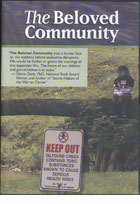
The Beloved Community 2004
Distributed by California Newsreel, Order Dept., PO Box 2284, South Burlington, VT 05407; 877-811-7495 (toll free)
Produced by Pamela Calvert
Directed by Pamela Calvert
DVD, color, 56 min.
College - Adult
Health Sciences, Public Health, Environmental Studies
Date Entered: 03/26/2008
Reviewed by Lori Widzinski, Health Sciences Library, University at Buffalo, State University of New YorkThe Beloved Community is the story of ecological disruption in Sarnia, Ontario and the adjacent First Nations community, and the impact on public health. For years big companies thrived in this region of Canada bordering beautiful Lake Huron. The residents made good livings working in the plants that produced chemicals, rubber, and solvents. Then in the mid 1990s, they started noticing some disturbing trends. More illnesses were reported—asthma, cancer, and birth defects. There was a huge jump in the number of girls being born, with the statistics proving that twice as many female births were occurring than male. Scientists and health officials noted this as one of the markers of endocrine disruption caused by chemicals in the environment. These phenomena started with the birds and fish in the area. People noticed abnormalities developing. As it progressed to the human population increases in disease, infertility and miscarriages appeared. The local public health officials started keeping track, through bodymapping, with distressing findings.
Calvert has documented the fight of the residents of Sarnia to clean up their land, and to say no to more big companies moving into the region. Energy giant Suncor decided against a plant in the area after strong resident opposition. Ironically, they are one of the least environmentally offensive businesses, but the residents of Sarnia are fed up. Retreating businesses also mean a loss of jobs and revenue for the area, but there are too many unanswered questions remaining about the health and viability of future generations. As one resident says in the film, "Sarnia is a microcosm for the rest of the world—industry for work is ruining our environment."
The film is well done, and Calvert gets the message across. It is a bit long for classroom use, at just under an hour, and a shorter educational version would be welcome. Recommended for library collections in public health and environmental science.